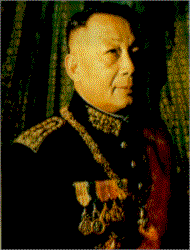Reign 1353 - 1372 Parents Chao Fa Ngiao Great grandchildren Phommathat Grandchildren Lan Kham Deng | Name Fa Ngum Children Samsenethai Predecessor None | |
 | ||
Vientiane discovered chao fa ngum park
Somdetch Brhat-Anya Fa Ladhuraniya Sri Sadhana Kanayudha Maharaja Brhat Rajadharana Sri Chudhana Negara, better known as Fa Ngum (Laotian: ຝ້າງູ່ມ [fȁːŋum]; 1316 – 1393, born in Muang Sua, died in Nan), established the Lao kingdom of Lan Xang in 1354.
Contents
- Vientiane discovered chao fa ngum park
- King of laos jao fa ngum 1 0002
- Early life
- King of Lan Xang Million Elephants
- Family
- References

King of laos jao fa ngum 1 0002
Early life
Phraya Fa Ngum, son of the exiled Phi Fa, grandson of Phraya Khamphong, and great-grandson of the exiled Phraya Lang, was born in 1316. He was raised by the religious scholar Maha Pasaman Chao (Phra Mahasamana). At sixteen, he married a Cambodian princess known variously as Kaeo, Yot Kaeo, or Kaeo Lot Fa.
Fa Ngoum or Fa Ngum was born in Muang Xwa, a Lao principality located on the site of present-day Luang Prabang, and founded the Lan Xang Hôm Khao (better known as Lan Xang) kingdom in Laos in 1353. Fa Ngoum (born 1316—died 1374) was a grandson of Souvanna Khamphong, titled Phagna Khampong, ruler of Muang Xwa and grandfather of Fa Ngoum, banished Fa Ngoum and his father, Chao Fa Ngiao, to the Khmer kingdom of Angkor in the 1320s due to his father's indiscretion with one of the grandfather's wives. Another source said that Fa Ngoum was sent to exile because Fa Ngoum was miraculously born with thirty-three teeth which was an omen of threatening the well-being of his grandfather's kingdom. Fa Ngoum subsequently married a Khmer princess Princess Kèo Kèngkanya. With the support of king of Angkor, Fa Ngoum returned to Muang Xwa with a 10,000 man army to gain control and consolidate his kingdom. Princess Kèo Kèngkanyalater died from plague, while he was campaigning North against the Mongols. In 1316–1374, Fa Ngoum founded the kingdom of Lan Xang Hôm Khao—"land of one million elephants and a white parasol." The elephant symbolized military power since most battles were fought using elephants, and the white parasol symbolized royalty, particularly a Buddhist monarch. Fa Ngoum further legitimized his rule by enshrining the Prabang Buddha image as the spiritual protector of the kingdom in Viang Chan Viang Kham (present-day Vientiane). He made Xiang Dong Xiang Thong (later renamed Luang Prabang) his capital.
Fa Ngoum is credited with introducing Khmer culture and Singhalese Buddhism to the region. His religious tutor, Maha Pasaman also brought back sacred texts and the Phra Bang.
Political turmoil ensued, and Fa Ngoum's son Oun Huan (Sam Sèn Thai, 1356–1417) succeeded the throne in 1368.
King of Lan Xang (Million Elephants)
Fa Ngum conquered western Nghệ An as well as the valleys between Red River and Black River in Vietnam (Tonkin) and modern day Isan in Thailand. In 1352–1354, he conquered Muang Sing, Muang Houm, Chiang Hung, Pak Ou and Pak Beng. In 1353, he conquered Vietiane, Xiang Khoang and then Luang Phrabang. He fought the ultimate battle against his uncle near Xiang Dong Xiang Thong and won, becoming the undisputed master of the land, which he named Lan Xang and in keeping with his Khmer wife's wishes, made Theravada Buddhism the state religion.
In 1373, the royals and nobles of his own court exiled him. His son Oun Huan, often called Samsenethai, a name adopted for the 300,000 Tai people of Lan Xang; then ascended to the throne of Lan Xang. Who was barely 18 when he acceded the throne. He was named after the 1376 census, which concluded that he ruled over 300,000 Tais living in Laos; samsèn means, literally, 300,000. He set up a new administrative system based on the existing muang , nominating governors to each that lasted until it was abolished by the Communist government in 1975. Samsènthai's death was followed by a period of unrest. Under King Xaiyachakkaphat-Phènphèo (1441–1478), the kingdom came under increasing threat from the Vietnamese. King Xaiyachakkaphat's eldest son, the Prince of Xianglo, secured a holy white elephant. The emperor of Vietnam, learning of this momentous discovery, asked to be sent some of the beast's hairs. Disliking the Vietnamese, the Prince dispatched a box of its excrement instead, whereupon the Emperor formed an improbably large 550,000 man army. The Prince's army numbered 200,000 and 2,000 elephants. The massive Vietnamese army finally prevailed and entered and sacked Luang Prabang. But shortly thereafter they were driven out by Xaiyachakkaphat-Phènphèo's son, King Souvanna Banlang (1478–1485). Peace was only fully restored under King Visounnarath (1500–1520).
Family
- Queen Keo Kang Ya - (from Khmer Empire) (m.1332; d. 1368)
- Prince Oun Huan - King of Lan Xang, b.1357-d.1416 (aged 60), r.1372-1417
- Prince Kham Kong
- Princess Keo Ketkasi
- Queen Keo Lot Fa (from Ayutthaya, daughter of King Ramadipati of Ayudhaya)
